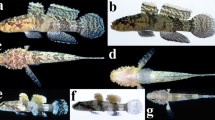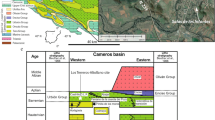Abstract
The major cranial arteries and veins are described for a 30-mm crown-rump length fetus of the pen-tailed tree shrewPtilocercus lowii, and comparisons are made with cranial vessels reported in the tree shrewTupaia and with the vascular pattern reconstructed for primitive eutherians.Ptilocercus shares a number of derived features of the cranial circulation withTupaia, which, therefore, represent synapomorphies of tree shrews (Tupaiidae, Scandentia). Included are (1) the enclosure of the intratympanic portion of the internal carotid artery in a bony canal that is floored proximally and distally by the entotympanic and by the petrosal in between, (2) the enclosure of the intratympanic portion of the stapedial artery by the petrosal in a canal on the promontorium and within the epitympanic crest beneath the tympanic roof, (3) the absence of an exit for the arteria diploëtica magna, (4) an alisphenoid canal, (5) a maxillary artery that passes medial to the mandibular nerve beneath foramen ovale, and (6) a laryngeopharyngeal artery. Some of these derived features, however, are also found in certain other eutherians (e.g., numbers 2, 3, and 6 in Euprimates) and, therefore, may be used in future studies to assess the higher-level affinities of Scandentia.
Similar content being viewed by others
Literature Cited
Adkins, R. M., and Honeycutt, R. L. (1991). Molecular phylogeny of the superorder Archonta.Proc. Natl. Acad. Sci. USA 88: 10317–10321.
Adkins, R. M., and Honeycutt, R. L. (1993). A molecular examination of archontan and chiropteran monophyly. In:Primates and Their Relatives in Phylogenetic Perspective, R. D. E. MacPhee, ed. pp. 227–249, Plenum Press, New York.
Bailey, W. J., Slightom, J. L., and Goodman, M. (1992) Rejection of the “flying primate” hypothesis by phylogenetic evidence from the ε-globin gene.Science 256: 86–89.
Berse, D. (1986).Die Ontogenese der Ala temporalis von Tupaia belangeriunter Berücksichtigung ihrer Lage zu den Blutgefässen, Diss. med., Georg August-Universität, Göttingen.
Bugge, J. (1972). The cephalic arterial system in the insectivores and the primates with special reference to the Macroscelidoidea and Tupaioidea and the insectivore-primate boundary.Z. Anat. Entwicklungsgesch.135: 279–300.
Bugge, J. (1974) The cephalic arterial system in insectivores, primates, rodents and lagomorphs, with special reference to the systematic classification.Acta Anat. 87 (Suppl. 62): 1–159.
Butler, P. M. (1972). The problem of insectivore classification. In:Studies in Vertebrate Evolution, K. A. Joysey and T. S. Kemp, eds., pp. 253–265, Oliver and Boyd, Edinburgh.
Cartmill, M., and MacPhee, R. D. E. (1980). Tupaiid affinities: the evidence of the carotid arteries and cranial skeleton. In:Comparative Biology and Evolutionary Relationships of Tree Shrews, W. P. Luckett, ed., pp. 95–132, Plenum Press, New York.
Diamond, M. K. (1991). Homologies of the stapedial artery in humans, with a reconstruction of the primitive stapedial artery configuration of Euprimates.Am. J. Phys. Anthropol. 84: 433–462.
Diamond, M. K. (1992). Homology and evolution of the orbitotemporal venous sinuses of humans.Am. J. Phys. Anthropol. 88: 211–244.
Evans, H. E., and Christensen, G. C. (1979).Miller's Anatomy of the Dog, W. B. Saunders, Philadelphia.
Gelderen, C. v. (1924). Die Morphologie der Sinus durae matris. Zweiter Teil. Die vergleichende Ontogenie der neurokraniellen Venen der Vogel and Säugetiere.Z. Anat. Entwickelungsgesch. 74: 432–508.
Hunt, R. M., Jr., and Korth, W. W. (1980) The auditory region of Dermoptera: Morphology and function relative to other living mammals.J. Morphol. 164: 167–211.
Janßen, S. (1993).Beitrag zur Ontogenese und Morphologie des Craniums von Ptilocercus lowii (Mammalia: Scandentia: Tupaiidae), Diss. med., Georg August-Universität, Göttingen.
Kay, R. F., Thewissen, J. G. M., and Yoder, A. D. (1992). Cranial anatomy ofIgnacius graybullianus and the affinities of the Plesiadapiformes.Am. J. Phys. Anthropol. 89: 477–498.
Le Gros Clark, W. E. (1926). On the anatomy of the pen-tailed tree-shrew (Ptilocercus lowii).Proc. Zool. Soc. London 1926: 1179–1309.
Lyon, M. W. (1913). Treeshrews: An account of the mammalian family Tupaiidae.Proc. U. S. Natl. Mus. 45: 1–188.
MacPhee, R. D. E. (1979) Entotympanics, ontogeny and primates.Folia Primatol. 27: 245–283.
MacPhee, R. D. E. (1981). Auditory regions of primates and eutherian insectivores: Morphology, ontogeny and character analysis.Contrib. Primatol. 18: 1–282.
MacPhee, R. D. E., and Cartmill, M. (1986). Basicranial structures and primate systematics. In:Comparative Primate Biology, Vol. 1 Systematics, Evolution, and Anatomy, D. R. Swindler and J. Erwin, eds., pp. 219–275, Alan R. Liss, New York.
Novacek, M. J. (1986). The skull of leptictid insectivorans and the higher-level classification of eutherian mammals.Bull. Am. Mus. Nat. Hist. 183: 1–112.
Presley, R. (1991). Homology of the tegmen tympani in eutherian mammals.J. Anat. 179: 235.
Rougier, G. W., Wible, J. R., and Hopson, J. A. (1992). Reconstruction of the cranial vessels in the early Cretaceous mammalVincelestes neuquenianus: Implications for the evolution of the mammalian cranial vascular system.J. Vert. Paleontol. 12: 188–226.
Saban, R. (1956/1957). Les affinités du genreTupaia Raffles 1821 d'après les caractères morphologiques de la tête osseuse.Ann. Paléontol. 42: 169–224,43: 1–43.
Saban, R. (1963). Contribution à l'étude de l'os temporal des Primates.Mém. Mus. Natl. Hist. Nat. Paris Sér. A 29: 1–378.
Stanhope, M. J., Bailey, W. J., Czelusniak, J., Goodman, M., Si, J.-S., Nickerson, J., Sgouros, J. G., Singer, G. A. M., and Kleinschmidt, T. K. (1993). A molecular view of primate supraordinal relationships from the analysis of both nucleotide and amino acid sequences. In:Primates and Their Relatives in Phylogenetic Perspective, R. D. E. MacPhee, ed., pp. 251–292, Plenum Press, New York.
Steuerwald, E. A. (1969).Review of the Phylogenetic Position of the Tree Shrew (Tupaia glisDiard),with New Observations on the Arteria Carotis Interna, Ph.D. dissertation Michigan State University, East Lansing.
Szalay, F. S. (1976). systematics of the Omomyidae (Tarsiiformes, Primates) taxonomy, phylogeny, and adatpations.Bull. Am. Mus. Nat. Hist. 156: 1–178.
Tandler, J. (1899). Zur vergleichenden Anatomie der Kopfarterien bei den Mammalia.Denkschr. kais. Akad. Wiss. Wien math.-naturw. Klasse 67: 677–784.
Verma, K. (1965). Notes on the biology and anatomy of the Indian tree shrew,Anathana wroughtoni. Mammalia 29: 289–330.
Wahlert, J. H. (1985). Cranial foramina of rodents. In:Evolutionary Relationships Among Rodents: A Multidisciplinary Analysis, W. P. Luckett and J.-L. Hartenberger, eds., pp. 311–332, Plenum Press, New York.
Wible, J. R. (1984).The Ontogeny and Phylogeny of the Mammalian Cranial Arterial Pattern, Ph. D. dissertation, Duke University, Durham, NC.
Wible, J. R. (1986). Transformations in the extracranial course of the internal carotid artery in mammalian phylogeny.J. Vert. Paleontol. 6: 313–325.
Wible, J. R. (1987). The eutherian stapedial artery: Character analysis and implications for superordinal relationships.Zool. J. Linn. Soc. 91: 107–135.
Wible, J. R. (1993). Cranial circulation and relationships of the colugoCynocephalus (Dermoptera, Mammalia).Am. Mus. Novitates 3072: 1–27.
Wible, J. R., and Covert, H. H. (1987). Primates: Cladistic diagnosis and relationships.J. Hum. Evol. 16: 1–22.
Wible, J. R., and Martin, J. R. (1993). Ontogeny of the tympanic floor and roof in archontans. In:Primates and Their Relatives in Phylogenetic Perspective, R. D. E. MacPhee, ed., pp. 111–148, Plenum Press, New York.
Yates, T. L. (1984). Insectivores, elephant shrews, tree shrews, and dermopterans. In:Orders and Families of Recent Mammals of the World, S. Anderson and J. K. Jones, Jr., eds., pp. 117–144, John Wiley & Sons, New York.
Zeller, U. (1983).Zur Ontogenese und Morphologie des Craniums von Tupaia belangeri (Tupaiidae, Mammalia), Diss. med., Georg August-Universität, Göttingen.
Zeller, U. (1986a). Ontogeny and cranial morphology of the tympanic region of the Tupaiidae, with special reference toPtilocercus.Folia Primatol. 47: 61–80.
Zeller, U. (1986b). The systematic relations of tree shrews: Evidence from skull morphogenesis. In:Primate Evolution, J. G. Else and P. C. Lee, eds., pp. 273–280, Cambridge University Press, Cambridge.
Zeller, U. (1987). Morphogenesis of the mammalian skull with special reference toTupaia. In:Morphogenesis of the Mammalian Skull, H.-J. Kuhn and U. Zeller, eds.,Mammalia depicta, Vol. 13, pp. 17–50, Paul Parey Verlag, Hamburg.
Author information
Authors and Affiliations
Rights and permissions
About this article
Cite this article
Wible, J.R., Zeller, U. Cranial circulation of the pen-tailed tree shrewPtilocercus lowii and relationships of Scandentia. J Mammal Evol 2, 209–230 (1994). https://doi.org/10.1007/BF01464275
Issue Date:
DOI: https://doi.org/10.1007/BF01464275




